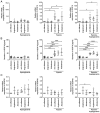Different responses of the MIO‑M1 Mueller cell line to angiotensin II under hyperglycemic or hypoxic conditions
- PMID: 37614982
- PMCID: PMC10442740
- DOI: 10.3892/br.2023.1644
Different responses of the MIO‑M1 Mueller cell line to angiotensin II under hyperglycemic or hypoxic conditions
Abstract
Members of the renin-angiotensin aldosterone system (RAAS) are expressed by various retinal tissues including Mueller glial cells. As the RAAS is hypothesized to play an important role in the pathogenesis of diseases that threaten vision, such as diabetic macular edema or retinal vein occlusion, the possible changes induced by exposure of the human cell line MIO-M1, an established model of Mueller cells, to angiotensin II or aldosterone for 6 h under hypoxic and/or hyperglycemic conditions were investigated. The mRNA expression levels of the members of the RAAS were assessed by reverse transcription-quantitative PCR, and the secretion of cytokines was assessed by ELISA. Under hyperglycemic conditions, the mRNA expression levels of the angiotensin-converting enzyme 2 (ACE2), angiotensin II receptors, AT1 and AT2, and the receptor of angiotensin (1-7) MAS1 were significantly higher after exposure to angiotensin II, and the expression of ACE2, AT2, and IL-6 (a marker of inflammation) was significantly increased after treatment with aldosterone; the expression of the other targets investigated remained unchanged. Significantly more IL-6 was secreted by MIO-M1 cells exposed to hyperglycemia and angiotensin. When cells were cultured in a hypoxic environment, additional treatment with aldosterone significantly increased the mRNA expression levels of ACE, but significantly more ACE2 mRNA was expressed in the presence of angiotensin II. Under hypoxic plus hyperglycemic conditions, significantly less ACE but more AT2 was expressed after treatment with angiotensin II, which also led to strongly elevated expression of IL-6. The mRNA expression levels of the angiogenic growth factor VEGF-A and secretion of the encoded protein were notably increased under hypoxic and hypoxic plus hyperglycemic conditions, irrespective of additional treatment with angiotensin II or aldosterone. These findings suggest that angiotensin II induces a pro-inflammatory response in MIO-M1 cells under hyperglycemic conditions despite activation of the counteracting ACE2/MAS1 signaling cascade. However, hypoxia results in an increased expression of angiogenic VEGF-A by these cells, which is not altered by angiotensin II or aldosterone.
Keywords: Mueller cells; aldosterone; angiotensin II; diabetic macular edema; renin-angiotensin aldosterone-system.
Copyright: © Beuse et al.
Conflict of interest statement
The authors declare that they have no competing interest.
Figures





Similar articles
-
[Expression of renin-angiotensin-aldosterone system in human adipose tissues].Zhongguo Yi Xue Ke Xue Yuan Xue Bao. 2006 Dec;28(6):766-9. Zhongguo Yi Xue Ke Xue Yuan Xue Bao. 2006. PMID: 17260463 Chinese.
-
Aldosterone, but not angiotensin II, reduces angiotensin converting enzyme 2 gene expression levels in cultured neonatal rat cardiomyocytes.Circ J. 2008 Aug;72(8):1346-50. doi: 10.1253/circj.72.1346. Circ J. 2008. PMID: 18654024
-
Local renin-angiotensin system is involved in K+-induced aldosterone secretion from human adrenocortical NCI-H295 cells.Hypertension. 1999 Apr;33(4):1025-30. doi: 10.1161/01.hyp.33.4.1025. Hypertension. 1999. PMID: 10205242
-
Antagonism of the renin-angiotensin-aldosterone system and collagen metabolism in cardiac fibroblasts.Methods Find Exp Clin Pharmacol. 1999 Apr;21(3):215-27. doi: 10.1358/mf.1999.21.3.534832. Methods Find Exp Clin Pharmacol. 1999. PMID: 10389125 Review.
-
Hypertension: renin-angiotensin-aldosterone system alterations.Circ Res. 2015 Mar 13;116(6):960-75. doi: 10.1161/CIRCRESAHA.116.303587. Circ Res. 2015. PMID: 25767283 Review.
Cited by
-
In vitro gastrointestinal digestion simulation screening of novel ACEI peptides from broccoli: mechanism in high glucose-induced VSMCs dysfunction.Front Nutr. 2025 Jan 27;12:1528184. doi: 10.3389/fnut.2025.1528184. eCollection 2025. Front Nutr. 2025. PMID: 39931369 Free PMC article.
References
-
- Ozaki H, Yu AY, Della N, Ozaki K, Luna JD, Yamada H, Hackett SF, Okamoto N, Zack DJ, Semenza GL, Campochiaro PA. Hypoxia inducible factor-1alpha is increased in ischemic retina: Temporal and spatial correlation with VEGF expression. Invest Ophthalmol Vis Sci. 1999;40:182–189. - PubMed
LinkOut - more resources
Full Text Sources
Research Materials
Miscellaneous
